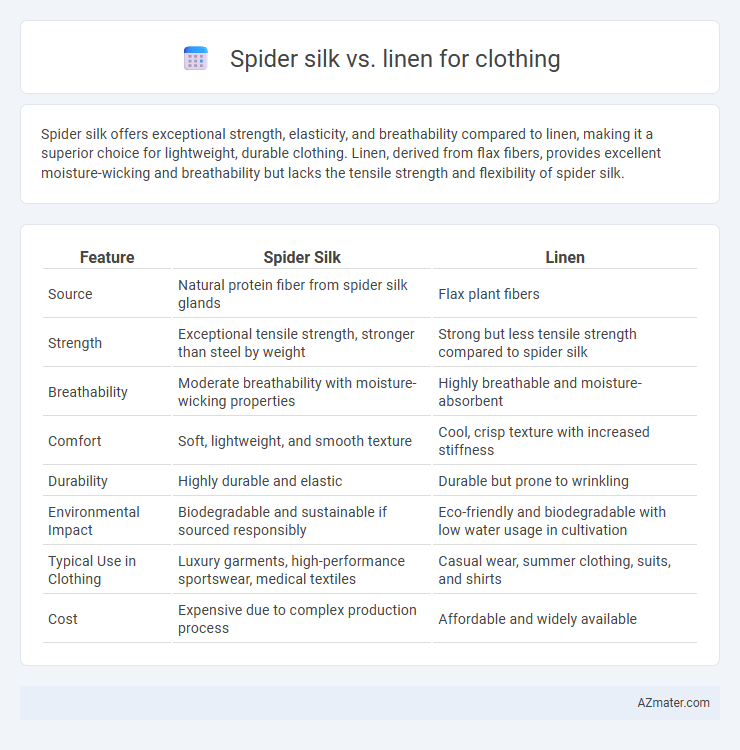Spider silk offers exceptional strength, elasticity, and breathability compared to linen, making it a superior choice for lightweight, durable clothing. Linen, derived from flax fibers, provides excellent moisture-wicking and breathability but lacks the tensile strength and flexibility of spider silk.
Table of Comparison
| Feature | Spider Silk | Linen |
|---|---|---|
| Source | Natural protein fiber from spider silk glands | Flax plant fibers |
| Strength | Exceptional tensile strength, stronger than steel by weight | Strong but less tensile strength compared to spider silk |
| Breathability | Moderate breathability with moisture-wicking properties | Highly breathable and moisture-absorbent |
| Comfort | Soft, lightweight, and smooth texture | Cool, crisp texture with increased stiffness |
| Durability | Highly durable and elastic | Durable but prone to wrinkling |
| Environmental Impact | Biodegradable and sustainable if sourced responsibly | Eco-friendly and biodegradable with low water usage in cultivation |
| Typical Use in Clothing | Luxury garments, high-performance sportswear, medical textiles | Casual wear, summer clothing, suits, and shirts |
| Cost | Expensive due to complex production process | Affordable and widely available |
Introduction: Comparing Spider Silk and Linen in Fashion
Spider silk offers unparalleled strength, elasticity, and lightweight properties compared to traditional linen fabric, making it a revolutionary material in high-performance and sustainable fashion. Linen, derived from flax fibers, boasts natural breathability, moisture-wicking capabilities, and durability, historically favored for its comfort in warm climates. The emerging use of bioengineered spider silk fibers introduces innovative potential for eco-friendly, durable, and luxurious textiles poised to complement or surpass linen in future fashion applications.
Origins and Production Methods
Spider silk originates from the protein fibers spun by spiders, harvested primarily through specialized farming involving the careful extraction of silk strands without harming the spiders. Linen is derived from the fibers of the flax plant, produced through a labor-intensive process that includes retting, drying, and weaving to transform the flax stalks into durable textile fibers. Both materials differ significantly in origin--biological secretion versus plant fiber--and production methods, with spider silk relying on emerging biotechnological innovations and linen using traditional agricultural and mechanical techniques.
Texture and Comfort: Feel Against the Skin
Spider silk offers a unique texture that is incredibly smooth and lightweight, providing a luxurious feel against the skin that is softer than many conventional fabrics. Linen, while breathable and cool, has a coarser texture that can sometimes feel rough or stiff, especially before multiple washes soften the fibers. The comfort of spider silk makes it ideal for sensitive skin and high-performance clothing, whereas linen excels in ventilation and moisture-wicking for hot climates.
Strength and Durability
Spider silk exhibits remarkable tensile strength, surpassing many natural and synthetic fibers, making it exceptionally durable for clothing applications. Linen, derived from flax fibers, offers considerable strength but is prone to wear and tear over time, especially when subjected to repeated stress. The superior tensile properties and elasticity of spider silk provide enhanced durability, making it a premium choice for long-lasting and resilient garments.
Breathability and Moisture Management
Spider silk offers superior breathability due to its natural microstructure, which allows efficient air circulation while maintaining lightweight comfort. Its moisture-wicking properties surpass linen by effectively drawing sweat away from the skin and drying rapidly, enhancing wearer comfort in humid conditions. While linen is breathable and absorbs moisture well, spider silk provides a more advanced moisture management system, resulting in better temperature regulation and reduced clamminess during wear.
Sustainability and Environmental Impact
Spider silk outperforms linen in sustainability due to its exceptional biodegradability and low resource consumption during production, requiring minimal water and no pesticides. Linen, derived from flax plants, is renewable and biodegradable but demands significant water and land use, alongside energy-intensive processing. The environmental impact of spider silk remains lower overall, offering a promising eco-friendly alternative to traditional textiles like linen.
Allergenicity and Skin Sensitivity
Spider silk offers remarkable hypoallergenic properties, making it ideal for individuals with sensitive skin or allergies, as it naturally resists bacteria and irritants. Linen, while breathable and moisture-wicking, can cause irritation for some users due to its rougher texture and potential for harboring allergens. Choosing spider silk clothing significantly reduces allergic reactions and skin sensitivity compared to linen, providing superior comfort for sensitive skin types.
Dyeability and Color Retention
Spider silk exhibits exceptional dyeability due to its protein-based fiber structure, allowing vibrant, long-lasting colors that resist fading even after multiple washes. Linen, composed of cellulose fibers, tends to absorb dyes less uniformly, resulting in more muted tones with a moderate degree of color retention that diminishes faster under sunlight and wear. The superior molecular makeup of spider silk enhances its colorfastness, making it a preferred material for garments requiring bright, enduring hues.
Cost and Accessibility
Spider silk, renowned for its exceptional strength and lightweight properties, remains prohibitively expensive due to complex harvesting processes and limited production scale, making it largely inaccessible for mainstream clothing markets. Linen, derived from flax plants, offers a cost-effective and widely accessible alternative with established manufacturing infrastructure, supporting large-scale production and affordability. While spider silk excels in performance, linen's practicality in cost and availability positions it as the preferred material for everyday apparel.
Future Prospects in Textile Innovation
Spider silk offers remarkable tensile strength, elasticity, and biodegradability, positioning it as a revolutionary material for future textile innovation. Advances in bioengineering and synthetic fiber production are enabling scalable spider silk alternatives that could outperform linen's durability and moisture-wicking properties. Emerging applications in high-performance athletic wear and sustainable fashion highlight spider silk's potential to transform the clothing industry beyond traditional linen fabrics.

Infographic: Spider silk vs Linen for Clothing
 azmater.com
azmater.com